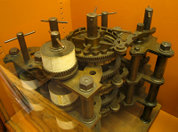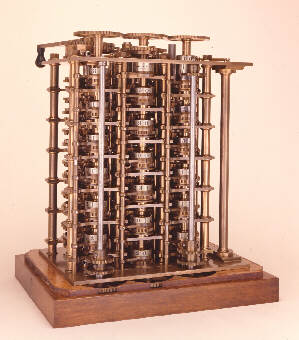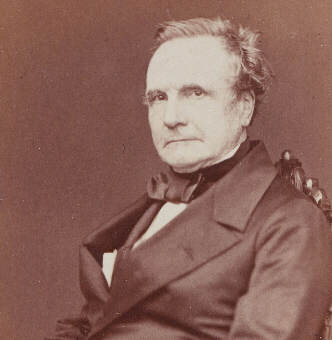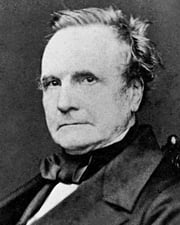Charles Babbage
1792- Charles Babbage, London, inventor (calculating machine)
Charles Babbage was born in London Dec. 26, 1791, St. Stephan day, in London. He was son of Benjamin Babbage, a banking partner of the Praeds who owned the Bitton Estate in Teignmouth and Betsy Plumleigh Babbage. It was about 1808 when the Babbage family decided to move into the old Rowdens house, located in East Teignmouth, and Benjamin Babbage became a warden of the nearby church of St. Michael.
The father of Charles was a rich man, so it was possible for Charles to receive instruction from several elite schools and teachers during the course of his elementary education. He was about eight when he had to move to a country school to recover from a dangerous fever. His parents sentenced that his "brain was not to be taxed too much"; Babbage wrote: "this great idleness may have led to some of my childish reasonings."
Then, he joined King Edward VI Grammar School in Totnes, South Devon, a thriving comprehensive school that's still operative today, but his fragile health status forced him back to private teaching for a period. Then, he finally joined a 30-student closed number academy managed by Reverend Stephen Freeman. The academy had a big library, where Babbage used to study mathematics by himself, and learned to love it. He had two more personal tutors after leaving the academy. One was a clergyman of Cambridge, and about him Babbage said: "I fear I did not derive from it all the advantages that I might have done.". The other one was an Oxford tutor who teached Babbage the Classics, so that he could be accepted to Cambridge.
Babbage arrived at Trinity College, Cambridge in October 1810. He had a big culture - he knew Lagrange, Leibniz, Lacroix, Simpson... and he was seriously disappointed about the math programs available at Cambridge. So he, with J.Herschel, G.Peacock, and other friends, decided to form the Analytical Society.
When, in 1812, Babbage transferred to Peterhouse, Cambridge, he was the best mathematician; but he failed to graduate with honours.
He received an honorary degree later, without even being examinated, in 1814.
In 1814, Charles Babbage married Georgiana Whitmore at St. Michael's Church in Teignmouth, Devon. His father, for some reason, never gave his approvation. They lived in tranquility at 5 Devonshire Street, Portland Place, London.
Only Three of their 8 children became adult.
Tragically, Charles' father, his wife and one of his sons all died in 1827.
Children
- Benjamin Herschel Babbage (1815)
- Charles Whitmore Babbage (1817)
- Georgiana Whitmore Babbage (1818)
- Edward Stewart Babbage (1819)
- Francis Moore Babbage (1821)
- Dugald Bromheald Babbage (1823)
- Henry Prevost Babbage (1824)
- Alexander Forbes Babbage (1827)
- Timothy grant Babbage (1829)
Design of computers
In Babbage's times there was a really high error rate in the calculation of math tables, when Babbage planned to find a new method that could be use to make it mechanically, removing the human error factor. This idea started to tickle his brain very early, in 1812.
Three different elements influenced him in this decision: he disliked untidiness and unprecision; he was very able with logarithmical tables; he was inspired from an existing work on calculating machines produced by W. Schickard, B.Pascal, and G. Leibniz.
He discussed the main principles of a calculating engine in a letter he wrote to Sir H. Davy in the early 1822.
Difference engine

Babbage presented something that he called "difference engine" to the Royal Astronomical Society on Jun 14, 1822 and in a paper entitled "Note on the application of machinery to the computation of astronomical and mathematical tables."
It was able to calculate polynomials by using a numerical method called the differences method.
The Society approved the idea, and the government granted him £1500 to construct it, in 1823.

Charles Babbage converted one of the rooms in his home to a workshop and hired Joseph Clement to oversee construction of the engine. Every part had to be formed by hand using custom machine tools, many of which Babbage himself designed. He took extensive tours of industry to better understand manufacturing processes. Based on these trips and his experience with the difference engine, Babbage published On the Economy of Machinery and Manufacture in 1832. It was the first publication on what we would now call operations research.
The death of Georgiana, Babbage's father, and an infant son interrupted construction in 1827. Work had already taxed Babbage heavily and he was on the edge of a breakdown. John Herschel and several other friends convinced Babbage to take a trip to Europe to recuperate. He passed through the Netherlands, Belgium, Germany, and Italy visiting universities and manufacturing facilities.
In Italy he learned he had been named the Lucasian Professor of Mathematics. He initially wanted to turn down the position but several friends convinced him to accept. He moved to 1 Dorset Street upon returning to England in 1828.
The difference engine project had come under fire during Babbage's absence. Rumours had spread that Babbage had wasted the government's money; that the machine did not work; and that it had no practical value if it did. John Herschel and the Royal Society publicly defended the engine. The government continued its support, advancing £1500 on April 29, 1829, £3000 on December 3, and £3000 on February 24, 1830. Work continued, but Babbage would have continual difficulty getting money from the treasury.
Babbage's problems with the treasury coincided with numerous disagreements with Clement. Babbage had built a two-story, 50 foot long workshop behind his house. It had a glass roof for lighting, and a fireproof, dust-free room to contain the machine. Clement refused to move his operations to the new workshop and demanded more money for the difficulty of travelling across town to oversee construction. In response, Babbage suggested that Clement draw his pay directly from the treasury. Before then, Babbage would get money from the government that he would use to pay Clement. He often had to pay Clement out of his own pocket when the bureaucracy lagged behind Clement's pay schedule. Clement refused the request and stopped working.
Clement further refused to turn over the drawings and tools used to build the difference engine. After an investment of £23000, including £6000 of Babbage's own money, work on the unfinished machine ceased in 1834. Charles wrote, "The drawings and parts of the Engine are at length in a place of safety—I am almost worn out with disgust and annoyance at the whole affair." In 1842 the government officially abandoned the project.
Analytical engine
While he was separated from the difference engine, Babbage began to think about an improved calculating engine. Between 1833 and 1842 he tried to build a machine that would be programmable to do any kind of calculation, not just ones relating to polynomial equations. The first breakthrough came when he redirected the machine's output to the input for further equations. He described this as the machine "eating its own tail". It did not take much longer for him to define the main points of his analytical engine.
The mature analytical engine used punched cards adapted from the Jacquard loom to specify input and the calculations to perform. The engine consisted of two parts: the mill and the store. The mill, analogous to a modern computer's CPU, executed the operations on values retrieved from the store, which we would consider memory. It was the world's first general-purpose computer.
A design for this emerged by 1835. The scale of the work was truly incredible. Babbage and a handful of assistants created 500 large design drawings, 1000 sheets of mechanical notation, and 7000 sheets of scribbles. The completed mill would measure 15 feet tall and 6 feet in diameter. The 100 digit store would stretch to 25 feet long. Babbage constructed only small test parts for his new engine; a full engine was never completed. In 1842, following repeated failures to obtain funding from the First Lord of the Treasury, Babbage approached Sir Robert Peel for funding. Peel refused, and offered Babbage a knighthood instead. Babbage refused. He would continue modifying and improving the design for many years to come.
In October 1842, Federico Luigi, Conte Menabrea, an Italian general and mathematician, published a paper on the analytical engine. Augusta Ada King, Countess of Lovelace, a longtime friend of Babbage, translated the paper into English. Charles suggested that she add notes to accompany the paper. In a series of letters between 1842 and 1843, the pair collaborated on seven notes, the combined length of which was three times longer than the actual paper. In one note Ada prepared a table of execution for a program that Babbage wrote to calculate the Bernoulli numbers. In another, she wrote about a generalized algebra engine that could perform operations on symbols as well as numbers. Lovelace was perhaps the first to grasp the more general goals of Babbage’s machine, and some consider her the world's first computer programmer. She began work on a book describing the analytical engine in more detail, but it was never finished.
Second Difference Engine
Between October 1846 and March 1849 Babbage started designing a second difference engine using knowledge gained from the analytical engine. It used only about 8000 parts, three times fewer than the first. It was a marvel of mechanical engineering.
Unlike the analytical engine that he continually tweaked and modified, he did not try to improve the second difference engine after completing the initial design. Babbage made no attempt to actually construct the machine.
The 24 schematics remained in the Science Museum archives until a full-size replica was built 1985-1991 to celebrate the 200th anniversary of Babbage’s birth. It measured 11 feet long, 7 feet high and 18 inches deep, and weighted 2.6 tonnes. The limits of precision were restricted to those achievable by Babbage.
Babbage's accomplishments
In 1824 Babbage won the Gold Medal of the Royal Astronomical Society "for his invention of an engine for calculating mathematical and astronomical tables".
From 1828 to 1839 Babbage was Lucasian professor of mathematics at Cambridge. He contributed largely to several scientific periodicals, and was instrumental in founding the Astronomical Society in 1820 and the Statistical Society in 1834.
In 1837, responding to the official eight Bridgewater Treatises "On the Power, Wisdom and Goodness of God, as manifested in the Creation", he published his Ninth Bridgewater Treatise putting forward the thesis that God had the omnipotence and foresight to create as a divine legislator, making laws (or programs) which then produced species at the appropriate times, rather than continually interfering with ad hoc miracles each time a new species was required. The book incorporated extracts from correspondence he had been having with John Herschel on the subject.
Charles Babbage also achieved notable results in cryptography. He broke Vigenère's autokey cipher as well as the much weaker cipher that is called Vigenère cipher today. The autokey cipher was generally called "the undecipherable cipher", though owing to popular confusion, many thought that the weaker polyalphabetic cipher was the "undecipherable" one. Babbage's discovery was used to aid English military campaigns, and was not published until several years later; as a result credit for the development was instead given to Friedrich Kasiski, who made the same discovery some years after Babbage.
Babbage also invented the pilot (also called a cow-catcher), the metal frame attached to the front of locomotives that clears the tracks of obstacles in 1838. He also performed several studies on Isambard Kingdom Brunel's Great Western Railway.
He only once endeavoured to enter public life, when, in 1832, he stood unsuccessfully for the borough of Finsbury. He came in last in the polls.
Parts of Babbage's uncompleted mechanisms are available for visits in the London Science Museum. In 1991 a difference engine was completed, starting from Babbage's original plans, and it functioned perfectly.
References and Bibliography
- Passages from the Life of a Philosopher (Charles Babbage).
- Charles Babbage: Pioneer of the Computer (Anthony Hyman).
- Irascible Genius: A Life of Charles Babbage, Inventor (Maboth Moseley).
- The Cogwheel Brain (Doron Swade).

A LUV.IT educational production.
This site will tell you Who is Charles Babbage, and you'll find - as well - Pictures of mathematician Charles Babbage and the Charles Babbage computer. Everything about Charles Babbage history and Charles Babbage difference engine models.
If you are asking yourself what did Charles Babbage invent, this is the ultimate place to visit. And a lot of Photos of Charles Babbage!





